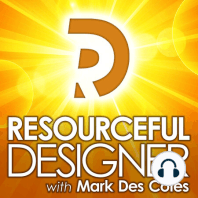26 min listen

The Psychology Of Pricing: Part 4 – RD267
FromResourceful Designer: Strategies for running a graphic design business
The Psychology Of Pricing: Part 4 – RD267
FromResourceful Designer: Strategies for running a graphic design business
ratings:
Length:
31 minutes
Released:
Aug 16, 2021
Format:
Podcast episode
Description
This is week four of my psychology of pricing series. Where I share research-proven strategies to influence people to part with their hard-earned money, some of these pricing tactics work great with your design business, and many of them are perfect for helping your clients get more sales. If you haven’t listened to part 1, part 2 or part 3 of this series, I suggest you do so before continuing with this one. Let’s continue with the series. As previously mentioned, I took the tactics I’m sharing here from an article by Nick Kolenda on his website nickkolenda.com on the psychology of pricing. Nick has links to many of the studies I mention in these episodes. Let’s get on with the list. Tactic 29: Create a Payment Medium. If you’ll recall the last episode, I talked about the Pain of Paying. That feeling we get when we have to part with our hard-earned money. Tactic 29 offers a great way to reduce that pain by creating a payment medium between the money spent and the purchased product. What is a payment medium? Casino chips are a great example. When gambling at a casino, it's much easier to place a $10 or $20 chip on the table than it would be if you had to put a ten or twenty dollar bill down. Casino chips act as a buffer between your wallet and the act of betting, which reduces the Pain of Paying. Another way this works, and possibly a way for you to incorporate this into your design business, is with advanced payments. If you charge clients by the hour, Instead of offering a monthly retainer agreement, you may instead offer a discount if a client pays for a pool of hours upfront, to be used at a later date. For example, if your regular rate is $100 per hour, twenty work hours should cost $2000. However, you could offer clients twenty hours of work to be used later for $1900. Your client would get 20 hours of your time banked for future use at a discounted price. The next time they have a design project, it won’t cost them anything because your time is already paid for. This creates a payment medium reducing the pain of paying. Should the client have a design idea they want to explore, it will be much easier for them to justify spending hours they’ve already paid for than it would be for them to justify spending the money on their idea even though it works out to the same thing in the end. Another thing to consider is a refundable deposit. Someone starting a venture that requires people to open an account to make purchases may require them to make a $50 refundable deposit when opening their account. This $50 can be used for future purchases or returned should the purchaser decide to close their account. Since the money required to open the account is refundable, there will be less resistance to depositing it. More importantly, the deposit now acts as a payment medium. People will be more willing to spend it on a purchase since it doesn’t feel like money coming out of their pocket. Tactic 30: Avoid Language Related to Money. This tactic works great when combined with tactic 29 above. Instead of referring to deposited money as money, you may want to refer to it as something else, such as credits. For example: Instead of clients buying 20 hours of your services. You have them buy 20 design credits, where each credit is worth up to 1 hour of design time. Then, when a client asks for a quote on a new design project, you can say it will cost them X credits. A 2004 study showed that using credits creates an off-balance conversion between the money and the value. This conversion creates a payment medium that is more effective as it’s more difficult for the customer to convert the values. A client with 20 design credits is likely to be more willing to spend 3 credits on a new project than spend $300 on it. Even though the two are essentially the value. Tactic 31: Emphasize the Inherent Costs of Your Product. People don't just care about the perceived magnitude of a price, for example, whether it’s high or low. They also care about the pe
Released:
Aug 16, 2021
Format:
Podcast episode
Titles in the series (100)
Selling Your Idea to Your Graphic Design Clients - RD025: The Client Isn't Always Right. The idea for this episode's topic about selling your idea to your client came about because of a Facebook group I'm part of. Recently a graphic designer posted a logo she was working on for critique. The logo was an... by Resourceful Designer: Strategies for running a graphic design business